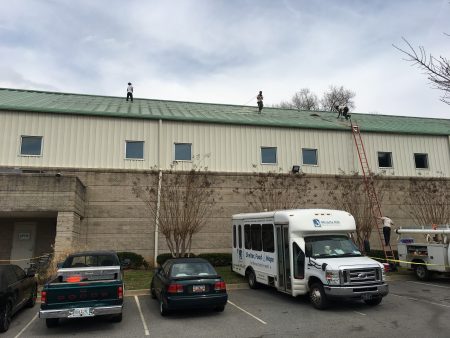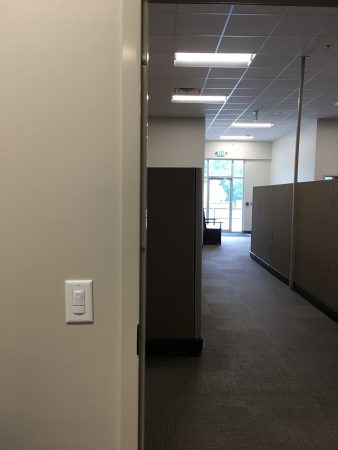
Solar panels at Miracle Hill’s Renewal addiction recovery center
The sun is shining on Miracle Hill, and with the addition of solar panels at four of the ministry’s nine shelters, we hope to capture as much of it as we can and conserve resources in the process.
It’s a project that began several months ago when Miracle Hill learned about grant money available through the Palmetto Clean Energy (PaCE) program. Coupled with rebates from Duke Energy, the grants are making it possible for the organization to transition to a renewable source of energy and in turn, to use more resources in direct care for the homeless.
On any given day, Miracle Hill cares for nearly 600 children and adults in our shelters and transitional houses, operates eight thrift stores and a food warehouse, and runs administrative operations and foster care. All in all, the organization is responsible for nearly a half million square feet of facility space. That’s a lot of lights, not to mention heating and cooling units, industrial kitchen appliances, dryers and washers and myriad other sources of energy consumption. Finding ways to conserve is not only helpful in the short term but ultimately will make the ministry more sustainable.
Tony McJunkin, Director of Facilities at Miracle Hill, has been heading up the solar project and says although it will pay off in the long run, the installation has required extensive planning and research on the front end.
“The upfront paperwork has proven to be much more involved and time consuming than originally anticipated,” said McJunkin. “We had to be sure that the roofs where the panels would be located would last for a minimum of 15 years and also have structural engineering studies conducted to ensure that the roofs would hold up the panels.”

Workers installing rails for solar panels at Greenville Rescue Mission

Completed solar panel installation at Greenville Rescue Mission
I happened to be attending a retirement party at the Greenville Rescue Mission for one of Miracle Hill’s long-time employees during the early stages of the Mission’s solar panel installation. As I sat in the gymnasium listening to heartfelt stories and well wishes, a deafening noise that sounded like ten jackhammers pummeling the ceiling all at the same time suddenly disrupted the event.
A Silent Source of Support
The noise continued off and on throughout the party and actually became quite funny as people experienced interruptions to their speeches. Stepping outside the building, I looked up to see workers installing the railings for attaching the massive solar panels that would soon be generating over 34,000 watts of power. It was an impressive undertaking. The solar panels are now online and have begun to generate power, a silent source of support for the nearly 100 homeless men who receive shelter and care within the walls of the Mission.
Miracle Hill is responsible to pay for the projects as they are constructed. Four shelters have been outfitted including the Greenville Rescue Mission, Renewal addiction recovery center, Spartanburg Rescue Mission, and Homes for Life youth shelter in Spartanburg. The out-of-pocket expense is projected to be slightly over $50,000, but the ministry will be reimbursed through grant money and Duke Energy rebates. After the projects are completed and all the monies received, the systems will be completely paid for, and Miracle Hill will have a little over $67,000 left for ministry.
“We are basically being paid to lower our electricity usage, resulting in a lower monthly electrical bill,” said McJunkin.

LED lighting and wall sensors at Miracle Hill’s administrative and foster care offices
In addition to the solar project, Miracle Hill is also in the process of converting the lighting in six facilities to cost-efficient LED lighting. As the organization constructs new or renovates existing facilities, the ministry is installing more automatic controls such as occupancy sensors for lighting and audiovisual systems, and programmable thermostats.
Partnerships Pave the Way for Progress
The LED lighting transition is made possible in part by Duke Energy rebates, a $40,000 matching pledge from an anonymous donor, and other donor contributions. The ministry is projecting energy savings of slightly over $1,000,000 over the next 10 years. Facilities included in the LED project are Greenville Rescue Mission, Renewal, Shepherd’s Gate, Overcomer Center, Spartanburg Rescue Mission and thrift stores in Travelers Rest, Taylors, Mauldin and Greenville.
Going forward, Miracle Hill would like to see qualified volunteers partner with the organization to assist with the cleaning and maintenance of the solar panels and systems. Additionally, the ministry would like to have energy audits conducted in all of the facilities to see what other opportunities for savings might be available.
“We want to be good stewards, both of the environment and the resources we have been blessed with,” said McJunkin.
Want to know more about Miracle Hill’s energy conservation projects or want to help? Contact Tony McJunkin at tmcjunkin@miraclehill.org. You can also learn more about solar energy in South Carolina by visiting Understand Solar.






